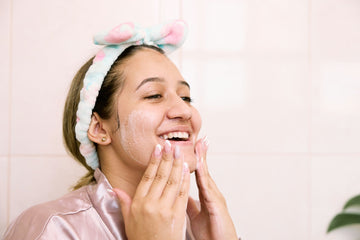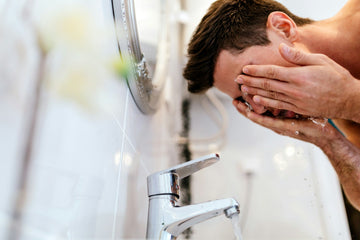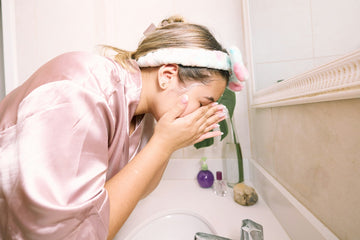Exfoliation is a crucial step in any skincare routine, helping to remove dead skin cells, improve skin texture, and enhance product absorption.
But where exactly does exfoliation fit into your skincare regimen?
This guide will help you understand the benefits, methods, and best practices for exfoliation so you can achieve smooth, radiant skin without damaging your skin barrier.
Understanding Exfoliation
What is Exfoliation?
Skin exfoliation is the process of removing dead skin cells from the surface of the skin. Over time, dead cells build up, leading to dullness, clogged pores, and uneven texture.
Regular exfoliation helps reveal brighter, healthier skin and supports better absorption of skincare products.
Types of Exfoliation
There are two main methods of exfoliation:
-
Physical (Mechanical) Exfoliation: Uses scrubs, brushes, or sponges to manually remove dead skin cells.
-
Chemical Exfoliation: Uses acids like alpha-hydroxy acids (AHAs) and beta-hydroxy acids (BHAs) to dissolve dead cells gently.
Benefits of Exfoliation
Why Should You Exfoliate?
-
Removes dead skin cells, revealing brighter, smoother skin.
-
Improves product absorption, allowing serums and moisturizers to work more effectively.
-
Prevents clogged pores, reducing breakouts and blackheads.
-
Boosts skin cell turnover, promoting faster skin regeneration.
-
Fades hyperpigmentation and dark spots, evening out skin tone over time.
Tip: Consistent exfoliation can help prevent dullness, fine lines, and breakouts, but it must be done correctly to avoid irritation.

How to Exfoliate Skin Properly
Step 1: Cleansing Before Exfoliation
-
Always cleanse your face before exfoliating to remove dirt, oil, and makeup.
-
Use a gentle cleanser suited for your skin type.
Step 2: Choose Your Exfoliation Method
Mechanical Exfoliation (Physical Exfoliation)
-
Involves using scrubs, brushes, or sponges to manually slough off dead skin cells from the skin's surface.
-
Best for: Normal, combination, and oily skin types.
-
How to use: Apply a small amount of scrub, massage gently in circular motions, and rinse with lukewarm water.
Avoid: Harsh, grainy scrubs with sharp particles that can cause microtears in the skin.
Chemical Exfoliation
-
Uses AHAs (like glycolic or lactic acid) or BHAs (like salicylic acid) to dissolve dead cells.
-
Best for: Sensitive, acne-prone, and dry skin.
-
How to use: Apply a thin layer of the chemical exfoliant after cleansing and before moisturizing.
Tip: If you're new to chemical exfoliation, start with low-concentration products and gradually increase usage.
Where Does Exfoliation Fit in Your Skincare Routine?
Exfoliation Step in a Skincare Routine
Exfoliation is typically done after cleansing and before toning or applying serums and moisturizers.
Standard Skincare Routine with Exfoliation:
-
Cleanser – Removes dirt, oil, and makeup.
-
Exfoliator (1-3 times a week) – Removes dead skin cells.
-
Toner – Balances pH and preps skin for hydration.
-
Serum – Delivers active ingredients for hydration, brightening, or anti-aging.
-
Eye Cream – Hydrates and protects delicate under-eye skin.
-
Moisturizer – Locks in hydration and strengthens the skin barrier.
-
Sunscreen (AM routine only) – Protects against UV damage.
Tip: If using a chemical exfoliant, you can skip the toner if it contains similar ingredients to prevent over-exfoliation.
Exfoliation Frequency Based on Skin Type
How Often Should You Exfoliate?
Your skin type determines how frequently you should exfoliate:
-
Oily Skin: 2-3 times a week to control oil and prevent clogged pores.
-
Dry Skin: 1-2 times a week to remove flakiness while maintaining hydration.
-
Sensitive Skin: Once a week with a gentle exfoliant to avoid irritation.
-
Combination Skin: 2 times a week while focusing on oily areas like the T-zone.
Tip: Over-exfoliating can lead to redness, dryness, irritation, and increased sensitivity to the sun.
Tips for Effective Exfoliation
-
Use gentle, non-abrasive exfoliants to prevent skin damage.
-
Exfoliate in circular motions to ensure even removal of dead skin cells.
-
Rinse with lukewarm water—hot water can cause dryness and irritation.
-
Follow with a moisturizer to restore hydration and maintain skin balance.
-
Avoid exfoliating on sunburned or irritated skin.
Tips for Beginners
Exfoliating can seem intimidating, especially for those new to skincare. Here are some tips for beginners:
-
Start Slow: Begin with a gentle exfoliant and gradually increase frequency or intensity as your skin becomes more tolerant. This helps prevent irritation and allows your skin to adjust.
-
Be Gentle: Avoid scrubbing too hard, as this can cause irritation and damage to the skin. Gentle, circular motions are best for removing dead skin cells without harming your skin barrier.
-
Choose the Right Exfoliant: Select an exfoliant that suits your skin type and concerns. For example, if you have dry skin, look for a gentle, hydrating exfoliant that won’t strip your skin of moisture.
-
Exfoliate at the Right Time: Exfoliate at night, as this allows your skin to absorb products better and helps prevent damage from environmental aggressors during the day.
-
Moisturize After Exfoliating: Apply a hydrating moisturizer after exfoliating to help lock in moisture and soothe the skin. This is crucial for maintaining a healthy skin barrier and achieving glowing skin.

Choosing the Right Exfoliant
With so many exfoliants on the market, it can be overwhelming to choose the right one. Here are some tips to help you make the right choice:
-
Consider Your Skin Type: If you have dry or sensitive skin, look for a gentle, hydrating exfoliant. For oily skin, a salicylic acid-based exfoliant can help control excess oil and prevent clogged pores.
-
Think About Your Skin Concerns: If you have acne-prone skin, look for an exfoliant containing glycolic acid or salicylic acid to help unclog pores and reduce inflammation. These ingredients are effective in removing dead skin cells and preventing breakouts.
-
Look for Gentle Ingredients: Avoid exfoliants containing harsh ingredients like microbeads or artificial fragrances, which can irritate the skin. Opt for products with natural enzymes or mild acids.
-
Read Reviews: Check out reviews from other users with similar skin types and concerns to get an idea of how well an exfoliant works. This can help you make an informed decision and find the best product for your needs.
Common Exfoliation Mistakes to Avoid
Over-Exfoliating
-
Can strip the skin of natural oils, leading to redness, irritation, and breakouts.
-
Signs of over-exfoliation include burning, excessive dryness, and increased sensitivity.
Using the Wrong Type of Exfoliant
-
Harsh scrubs with large beads can cause microtears, damaging the skin barrier.
-
Strong acids can be too aggressive for sensitive skin.
Skipping Sunscreen After Exfoliation
-
Exfoliation makes skin more sensitive to UV rays, increasing the risk of sunburn and hyperpigmentation.
-
Always apply a broad-spectrum SPF 30+ sunscreen after exfoliating.
Exfoliating for Your Skin Type
Oily Skin
-
Use BHAs (like salicylic acid) to control oil and prevent acne.
-
Exfoliate 2-3 times a week for best results.
Dry Skin
-
Choose gentle AHAs (like lactic acid) to remove dead skin without stripping moisture.
-
Exfoliate 1-2 times a week to maintain smooth texture.
Sensitive Skin
-
Stick to enzyme exfoliants (like papaya or pumpkin enzymes) to avoid irritation.
-
Limit exfoliation to once a week.
Sun Protection After Exfoliation
Exfoliating removes the top layer of dead skin, making the skin more vulnerable to sun damage.
-
Always apply sunscreen with SPF 30 or higher after exfoliating.
-
Avoid excessive sun exposure, especially after chemical exfoliation.
Exfoliation and Makeup
Exfoliating can help improve the appearance of your skin, making it a great addition to your skincare routine. But how does exfoliation affect makeup? Here are some tips:
-
Exfoliate Before Makeup: Exfoliating helps remove dead skin cells and smooth out the skin’s surface, making it a great prep step for makeup. This ensures a more even application and a flawless finish.
-
Use a Gentle Exfoliant: Avoid using harsh exfoliants that can strip the skin of its natural oils, as this can affect the way makeup applies. Gentle exfoliation is key to maintaining a healthy skin barrier.
-
Moisturize After Exfoliating: Applying a hydrating moisturizer after exfoliating helps lock in moisture and create a smooth canvas for makeup. This step is essential for achieving a dewy, glowing skin look.
-
Be Gentle When Removing Makeup: Avoid using harsh makeup removers that can strip the skin of its natural oils. Instead, use a gentle makeup remover and follow up with a hydrating moisturizer to keep your skin balanced and healthy.
By following these tips, you can ensure that your exfoliated skin looks its best both with and without makeup.
Adding Exfoliation to Your Skincare Routine
-
Start with once-a-week exfoliation, then gradually increase frequency as needed.
-
Avoid using multiple exfoliating products (like retinol + chemical exfoliants) on the same day.
-
Adjust your exfoliation routine based on seasonal changes—reduce frequency in winter if your skin gets drier.
Frequently Asked Questions
Where does exfoliation go in a skincare routine?
Exfoliation should be done after cleansing and before applying serums or moisturizers.
At what stage should you exfoliate your face?
Exfoliate after cleansing but before toner, serum, or moisturizer for best results.
What are the 7 steps of skincare?
-
Cleanser
-
Exfoliator (1-3x per week)
-
Toner
-
Serum
-
Eye Cream
-
Moisturizer
-
Sunscreen (AM routine only)
What are the best ingredients for exfoliation?
-
AHAs (Glycolic & Lactic Acid): Brighten skin and improve texture.
-
BHAs (Salicylic Acid): Great for acne-prone and oily skin.
-
Enzymes (Papaya, Pineapple): Gentle exfoliation for sensitive skin.
What Step is Exfoliation in Skincare? A Simple Guide to Your Routine Conclusion
Exfoliation is an essential step in any skincare routine that helps improve skin texture, brightness, and product absorption.
By choosing the right exfoliation method, frequency, and products for your skin type, you can enjoy a radiant, healthy glow while avoiding irritation.





